Senior Research Projects 2019 - 2020
Seniors present to the physics department the results of their Phys 489/490: SYE Advanced Laboratory and Phys 499: Honors SYE research projects at the end of each semester. The abstracts for their research are below and photos of the student presenters follow afterwards:
Spring 2020
Harvesting the Lost Energy of Bicycle Suspension with a Linear Electromagnetic Generator - Caleb Clarke '20
Shock absorbers have come into widespread use in both the automotive and bicycle industries to effectively reduce vibrational forces caused by road and trail irregularities. Their excretion of excess thermal energy offers a platform of energy regeneration, a field of study that has been researched in the automotive industry since the mid-1990’s. Since then, a variety of regenerative suspension prototypes have been modeled and manufactured, however this innovation has not yet transferred over into the bicycle industry where similar shock absorber technologies have been implemented. This paper details the design, production and testing of two linear electromagnetic generator prototypes modeled around an implementation within the bicycle industry. Following an analysis of the voltage output of the two generator prototypes a third linear electromagnetic generator design is proposed in an aim to improve the system’s overall power output efficiency.
For more information, contact Dr. Catherine Jahncke
Fall 2019
Adulteration Identification of Olive Oil Using Raman Spectroscopy - Connor Fletcher '20
Vegetable oils are manufactured on a wide scale for both commercial and domestic consumption and are one of the most predominant sources of fat in a lot of diets worldwide. They are used in various ways including, but not limited to, uses in marinades and sauces but also to drizzle over a salad, mix into salad dressing, and as a healthy alternative to butter or margarine in cooking. Regardless of how it is used, olive oil is highly regarded for its extremely positive impact on human health. Olive oils and other vegetable oils have been found to be linked to many health benefits with consistent consumption. The fatty acids in the oil have been found to reduce the risk of heart disease by lowering cholesterol and reducing blood clotting caused by monounsaturated fatty acids. (A.J.R. Bauer, Ph.D. 2014) These fatty acids have also been linked to improving insulin levels and improving blood sugar regulation. Olive oil is categorized by its oleic acid content and its high content in polyphenol compounds. (Camerlingo, C., Portaccio, M., Delfino, I., & Lepore, M.,2019) These compounds, however, can vary based on several factors including vegetable variety, ripening degree, geographical origin, growing conditions, and extraction process. The majority of the fatty acids in olive oil are triacylglycerols which are three fatty acid moieties with a glycerol backbone. (Bauer, 2014) Olive oil contains greater amounts of oleic acid compared to linolenic, palmitic acid, and linoleic acids which are polyunsaturated acids. This concentration of fatty acid components and profiles are naturally different than other oils, creating a way to differentiate the olive oil from any other possible adulterant. Since these fatty acids have different molecular structures, they will have different intermolecular vibrations which can be detected with the use of vibrational Raman spectroscopy allowing for the determination of possible adulterants. One of the main differentiators is that oleic acid is monounsaturated and linoleic acid is polyunsaturated meaning that since they are both 18- carbon carboxylic acids oleic acid only has one cis double bond and linoleic acid has two. (Duraipandian, Petersen, Lassen,2019).
For more information, contact Dr. Catherine Jahncke
Building a Table Top Watt Balance - Jake Laser '20
The kilogram has recently been redefined. It’s no longer determined by a physical object susceptible to erosion but is now tied to the unchanging universal Planck’s constant h. To measure mass using the kilogram’s new definition, a device called a Watt balance can be used. A Watt balance measures h using the equivalence between mechanical and electrical energies. The National Institute of Standards and Technology (NIST) have spent the last 10 years building such a device capable of measurements with a precision of a few parts in 109. NIST have also released plans for a small tabletop Watt balance that operates on the same principles. In this paper I construct this Watt balance that is capable of measuring mass as well as Planck’s constant h. I test its capabilities and limitations, as well as explore potential methods of improvement.
For more information, contact Dr. Catherine Jahncke



